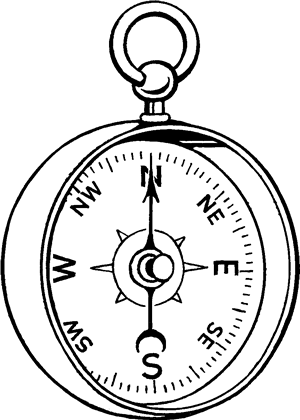A compass is an instrument containing a freely suspended magnetic element which displays the direction of the horizontal component of the Earth’s magnetic field at the point of observation.
Magnetic Compass
The magnetic compass is an old Chinese invention, probably first made in China during the Qin dynasty (221-206 B.C.). Chinese fortune tellers used lodestones (a mineral composed of an iron oxide which aligns itself in a north-south direction) to construct their fortune telling boards.
Eventually someone noticed that the lodestones were better at pointing out real directions, leading to the first compasses. They designed the compass on a square slab which had markings for the cardinal points and the constellations. The pointing needle was a lodestone spoon-shaped device, with a handle that would always point south.
The magnetic compass is an old Chinese invention, probably first made in China during the Qin dynasty (221-206 B.C.). Chinese fortune tellers used lodestones (a mineral composed of an iron oxide which aligns itself in a north-south direction) to construct their fortune telling boards.
Eventually someone noticed that the lodestones were better at pointing out real directions, leading to the first compasses. They designed the compass on a square slab which had markings for the cardinal points and the constellations. The pointing needle was a lodestone spoon-shaped device, with a handle that would always point south.
Magnetized Needles
Magnetized needles used as direction pointers instead of the spoon-shaped lodestones appeared in the 8th century AD, again in China, and between 850 and 1050 they seem to have become common as navigational devices on ships.
Magnetized needles used as direction pointers instead of the spoon-shaped lodestones appeared in the 8th century AD, again in China, and between 850 and 1050 they seem to have become common as navigational devices on ships.
Compass as a Navigational Aid
The first person recorded to have used the compass as a navigational aid was Zheng He (1371-1435), from the Yunnan province in China, who made seven ocean voyages between 1405 and 1433.
The first person recorded to have used the compass as a navigational aid was Zheng He (1371-1435), from the Yunnan province in China, who made seven ocean voyages between 1405 and 1433.
Ferrites or magnetic oxides are stones that attract iron and other metals. These are natural magnets and are not inventions. However, the machines that we make with magnets are inventions.
Ferrites were first discovered thousands of year ago. Large deposits were found in the district of Magnesia in Asia Minor, giving the mineral’s name of magnetite (Fe3O4).
Ferrites were first discovered thousands of year ago. Large deposits were found in the district of Magnesia in Asia Minor, giving the mineral’s name of magnetite (Fe3O4).
Magnetite was nicknamed lodestone and used by early navigators to locate the magnetic North Pole. William Gilbertpublished De Magnete, a paper on magnetism in 1600, about the use and properties of Magnetite. In 1819, Hans ChristianOersted reported that when an electric current in a wire was applied to a magnetic compass needle, the magnet was affected – this is called electromagnetism.
In 1825, British inventor William Sturgeon (1783-1850) exhibited a device that laid the foundations for large-scale electronic communications: the electromagnet. Sturgeon displayed its power by lifting nine pounds with a seven-ounce piece of iron wrapped with wires through which the current of a single cell battery was sent.
Cow Magnets
U.S. patent # 3,005,458 is the first patent issued for a cow magnet issued to Louis Paul Longo, the inventor of the Magnetrol Magnet, for prevention of hardware disease in cows
U.S. patent # 3,005,458 is the first patent issued for a cow magnet issued to Louis Paul Longo, the inventor of the Magnetrol Magnet, for prevention of hardware disease in cows

No comments:
Post a Comment